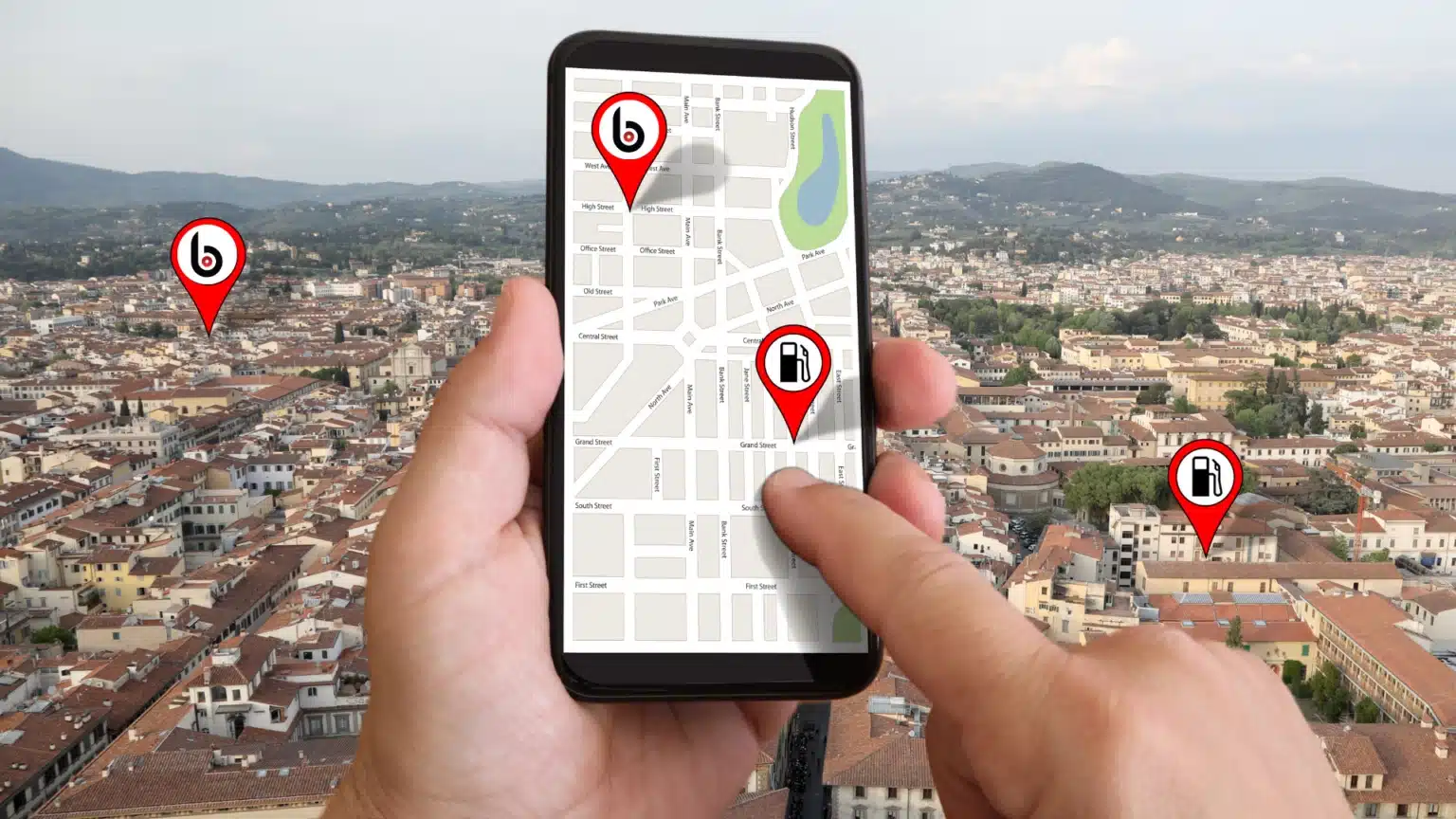If you own a brick-and-mortar business, you know firsthand that it’s been increasingly challenging to direct foot traffic to any physical location, let alone a small company. If only you could open a virtual perimeter around your physical location that entices potential customers to your store, then your marketing strategy would take off. Well, what if we told you that successful location-based marketing is possible through a geofencing campaign?
Geofencing advertising is a local, mobile advertising solution that allows marketers to target smartphone users when they enter a specified radius. Geofencing marketing takes hyper-local targeting to a whole new level, especially as more consumers are finding more businesses online than ever before.
More than half of smartphone users have discovered a new business or product when searching on their devices. A massive 53% of shoppers have visited a brick-and-mortar retailer after receiving a location-based message. And if you need more convincing to try geofencing marketing, mobile ads with geofencing capabilities have double the click-through rate.
Now is the time to learn more about geofencing marketing campaigns and how to leverage them in your business.
What is Geofencing in Marketing?
Geofencing marketing is a strategy that enables businesses to target individuals within a given geographical radius known as a ‘geo-fence.’ Using either GPS, RFID, Wi-Fi, or cellular data, companies can create geofence boundaries, which, when crossed, can trigger a series of programmable actions including SMS and push notifications, social media ads, mobile display ads, and navigation-based app ads sent to a potential customer’s mobile device.
In other words, geofencing advertising leverages the data around a physical location to target specific customers, known as a geofenced area. Geofencing can be highly successful in a marketing campaign, with 3 out of 4 consumers completing a target action when receiving a programmed text message after approaching a designated location. Since more than 85% of Americans own a smartphone, this location-based marketing tactic has a considerable reach.
How Effective is Geofencing Marketing?
Though there is a significant target audience for addressable geofencing, like other marketing efforts, a sizable demographic won’t guarantee success for geofencing marketing. So, how effective is the average geofence marketing strategy? Let’s look at the facts:
- Geofencing mobile marketing is compatible with 92% of smartphones, where the average consumer spends five hours per day browsing.
- Ads delivered via a geofencing marketing campaign have doubled the click-through rates of standard advertisements.
- 71% of consumers prefer a personalized ad experience that’s compatible with a geofence marketing campaign, and 62% of adults are willing to share their location for more relevant content
The Global Geofencing Market has a projected compound annual growth rate (CAGR) of 27%, with analysts predicting that the market size will reach $2.3 billion by 2023. According to a February 2021 Global Geofencing report, North America is currently dominating geofencing efforts. Leaders in the industry include U.S.-based software companies like Apple and Thumbvista, as well as Dataxu, Factual, GroundTruth, and Placed.

Typically, large companies like Apple have more disposable funds to test various advertising and marketing methods quickly. However, these corporations only maintain practices that are profitable. So, for major corporations to continue putting additional ad spend into geofencing, it’s a sign that mobile marketing is here to stay.
Examples of Geofencing Marketing Notifications
Large software companies are key players in the rise of the geofencing market. So, it’s no surprise that geofencing technology has been leveraged in B2B marketing for software and cloud-based brands. In the B2B segment, marketers can create a geofence around the area where a B2B buyer works at the street or city level, such as Silicon Valley, to target a potential customer directly.
However, if you own or market for a brick-and-mortar location, you can expect some differences in B2B versus B2C geofencing strategies. For instance, B2B marketing typically places a geofence around the physical area for local customers, where B2C marketing often places a geofence around the actual location of a brick-and-mortar business. A fantastic example of geofencing in physical locations is Burger King’s recent “Whopper Detour” mobile ad.
In a stroke of genius franchise marketing, Burger King built a 600-foot geofence around McDonald’s restaurants that, once entered by Burger King app users, could unlock a one-cent Whopper burger on their mobile device. The result? The Burger King app was downloaded more than 1 million times and rose from ninth to first place in the Apple App Store’s food and drink category.
How to Set Up a Geofencing Marketing Campaign
If you’re interested in setting up a geofencing marketing campaign, you’ll be pleased to learn that geofencing ads can occur across the same platforms you’re already leveraging for your marketing strategy, including Google Ads, mobile display ads, Facebook, Instagram, Twitter, Snapchat, Pinterest, and navigation-based apps.
Here’s a quick overview of establishing geofencing ads for each platform.
1. Google Ads
Marketers can create geofencing Google ads for search results pages, display, and YouTube. To set up geofencing ads on Google, choose a campaign and toggle to its Setting tab. From here, you can select from a variety of geofencing options, including Zip Code, Metro, City, State, Country, or Radius. To target a brick-and-mortar location, manually enter the exact address. Be sure to input additional targeting methods, such as Google’s affinity audiences, to be more specific.
There are typically two buying models for geofencing campaigns: CPM (Cost per Mille or Cost per 1,000 impressions) and CPV (Cost per Visit). To remove the guesswork from traditional media buying, opt for buying on a CPV model instead, guaranteeing you will only pay for ads that result in a store visit. A CPV model is ideal for tracking KPIs grounded in real-world outcomes, like physical foot traffic and in-store visits from previous customers. Bear in mind, CPV traffic will vary based on factors like the number of drive-to brick-and-mortar locations used in the campaign.
2. Geotargeted Mobile Display
Mobile display ads, or the website banner ads shown to smartphone users, are a high point of interest for geofencing marketing techniques. Beyond just triggering when a user enters a geofence boundary, mobile display ads can leverage several location-based factors to reach a hyper-specific audience.
For instance, weather targeting allows marketers to use upcoming weather conditions to target promotions. Likewise, geo-conquesting techniques use the location of your competitors to reach potential customers and entice them to your brick-and-mortar instead. These ad campaign results can also provide deep insights into your customers’ shopping behavior.
3. Facebook and Instagram
The abilities for geofencing on Instagram and Facebook advertising are flexible depending on your objectives. To build a geofencing campaign on either social media platform, create a standard marketing campaign, and toggle to the Audiences segment. Head to Locations to select a physical location for your target users. If you qualify, Facebook has a Store Visit bidding option that narrows the addressable geofencing area to a 0.5 mile-radius for your store list.
If you have multiple store locations, opt for ‘Add bulk locations’, import your list of stores, and add all matched locations to your campaign. If preferred, you can use the ‘Drop Pin’ feature to choose an exact location on a map interface. Alternatively, you can expand your radius beyond 1 mile to target an entire city or town, or you can exclude locations from your campaign, such as an area of a city you don’t want to target.
4. Twitter
Like Facebook and Instagram, Twitter boasts a significant area for geofencing. To establish a geofencing marketing campaign, marketers will follow the same steps as above. Customize the specific areas chosen for one ad to better control the spread by state, city, or neighborhood; or select the language spoken in the target area to customize geofencing ads to those who speak and understand a particular language, which will be helpful if the ad will be shown to an entire country.
5. Snapchat
In comparison to the above options, Snapchat geofencing offers the smallest radius, allowing marketers to become highly specific. When building a Snapchat ad campaign, marketers can choose from country, state, city, and various geographical divisions to construct their ideal target audience. It’s possible to also drop a pin at a specific location, such as a brick-and-mortar store.
Since the Snapchat social platform is a bit different than Instagram or Facebook, marketers leveraging this tool for geofencing will likely push targeted story advertisements and filters to their selected audience based on a user’s physical location.
The more users who select a branded filter, the higher chances of increased brand awareness in the area.
6. Pinterest
Pinterest offers “location targeting” for marketers to advertise based on country, region, metro area, postal code, or designated market area (DMA). In the Pinterest ads manager, marketers should head to the New Ad group tab on the main Ads navigation. Select targeting, scroll to Locations, then choose Pick Specific Locations to add regions, metros, or postal codes.
7. Navigation-Based Apps
Navigation-based apps, such as Google Maps and Waze, serve as the perfect opportunity to target consumers while they’re already on the road. Google Map advertising is powered by geographic location, so brick-and-mortar business owners should connect their Google My Business listing to their Google Ads campaigns to allow ads to appear in the maps section of search that corresponds with concurring Google Ads.
Alternatively, marketers can look into Waze ads — like Branded Pins, Promoted Search, and Zero-Speed Takeovers, which are a unique geofencing marketing tactic that triggers a banner ad to appear across the top of a user’s screen when the driver has come to a complete stop once they approach a specific radius of your business. Marketers can target by driver interests and age, destination, business opening hours, and even weather.
Potential Roadblocks in a Geofencing Advertising Campaign
While it’s simple enough to create a geofencing campaign, there still might be some hiccups in your overall geofencing strategy. For instance, in most of the platforms above, users have to be actively scrolling on Google, Facebook, or Twitter to receive targeted ads. You might be wondering if it’s worth the ad spend to target users in this way.
Fortunately, there is software on the market, like MoEngage and WebEngage, to help with mobile push, email, SMS, and on-site messaging, as well as Facebook Audiences and in-app messaging. However, without the help of a digital marketing agency, the tools meant to simplify geofencing can just overly complicate the entire process.
Why Should Chief Marketing Officers Care About Geofencing?
Optimizing marketing spend is a critical objective for marketing officers, who efficiently allocate budgets to drive maximum return on investment (ROI). The challenge often lies in ensuring that each dollar spent contributes to tangible business outcomes, such as increased sales, higher customer engagement, or enhanced brand awareness. Traditional marketing strategies that cast a wide net often result in significant expenditure on campaigns that may not reach the intended or most receptive audience, leading to inefficiencies and questioned ROI. Geofencing marketing technology offers a strategic solution to these challenges by enabling more targeted, efficient, and effective marketing spend. Let’s explore this in more detail:
Focused Resource Allocation
Geofencing allows marketing officers to create virtual boundaries around specific geographic locations, such as a store, event venue, or even a competitor’s location. This capability ensures that marketing efforts are concentrated on consumers physically present in or near areas of strategic importance to the brand. By focusing resources on these consumers, companies can more effectively deploy their marketing budgets toward audiences with a higher propensity to engage with the brand, visit a store, or make a purchase.
Improved Conversion Rates
One of the most significant advantages of geofencing marketing is its impact on conversion rates. When consumers receive marketing messages that are relevant to their current location and context, they are more likely to find the information useful and take action. For instance, a customer near a retail store might receive a timely promotion or discount, which could be the deciding factor in their decision to visit the store and make a purchase. This relevancy boosts the effectiveness of marketing campaigns, leading to higher conversion rates compared to broader, less targeted efforts.
Reduction in Wasted Expenditure
Geofencing marketing’s targeted approach also means less budget is wasted on reaching consumers unlikely to engage with the brand. Traditional advertising methods, such as mass media campaigns, do not offer the same level of targeting precision and often result in spending on impressions that do not convert to sales or desired actions. By contrast, geofencing ensures that marketing spend is directed toward consumers based on their real-world behaviors and likelihood of interest in the brand, thereby reducing wasteful expenditure.
Data-Driven Insights for Further Optimization
Moreover, geofencing marketing generates valuable data that marketing officers can use to analyze the effectiveness of their campaigns. Insights into customer foot traffic, dwell time, and conversion rates associated with specific geofenced campaigns provide a clear picture of what works and what doesn’t. This data allows for continuous optimization of marketing strategies and budgets, ensuring that future spend is even more targeted and effective.
Competitive Advantage
Lastly, optimizing marketing spend through geofencing improves efficiency and provides a competitive advantage. Brands that can engage customers more effectively and efficiently will likely see improved market share and customer loyalty. This strategic advantage is particularly crucial in competitive sectors where marketing innovation can differentiate a brand and drive growth.
Geofencing marketing addresses a fundamental challenge for marketing officers: allocating limited marketing budgets for maximum impact. By enabling highly targeted, location-based marketing campaigns, geofencing helps optimize marketing spend, driving better conversion rates, reducing wasted expenditure, and ultimately proving ROI. This targeted approach, underpinned by data-driven insights, allows for continual refinement of marketing strategies, ensuring that companies meet and exceed their marketing objectives.
Geofencing Can Be Tricky—Let Us Help!
Though geofencing marketing is on the rise, not every marketer has been brought up to speed on what it entails. Rather than stretch your marketing efforts too thin, contact experts who know how to ramp up your geofencing capability successfully. At Bullseye Strategy, our digital marketing leaders are ready to help you succeed with location-based marketing. Contact us today to get started.







